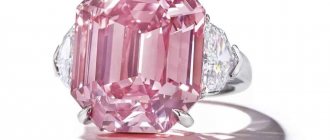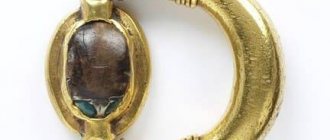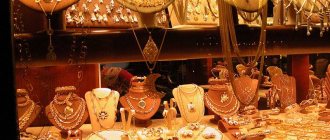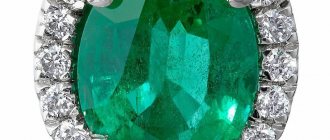Lee Siegelson knows everything about jewelry. A third-generation jeweler, he has spent many years appraising, collecting and selling show-quality vintage jewelry from his Fifth Avenue office. His grandfather Louis opened the family business in 1920, and over time the family collection grew into an impressive collection that is today considered one of the most prominent in the international jewelery community.
Many pieces from this collection have been sold or exhibited in top museums, including the Cooper-Hewitt National Design Museum and the Smithsonian Institution. Exclusively for Robb Report, Siegelson created a short course on the history of jewelry from Calder to Van Cleef; told which brooch was Jeanne Boivin’s favorite and what aeronautical design has in common with the works of Jean Despres. Remember a few facts to shine in your conversation at a social party.
Joel Arthur Rosenthal
Joël Arthur Rosenthal, better known as JAR, began his jewelry career 40 years ago after earning a degree in art history from Harvard. In 1977, the self-taught designer opened his small store on Place Vendôme in Paris, and since then he has not changed his place of work.
Each and every one of Rosenthal's works are extraordinary "living" jewelry sculptures adorned with vibrant gemstones. Many works often use a blackened alloy of silver and gold, which Joël himself developed.
Every year he creates about a hundred new jewelry creations (some of which are made to order), which are in incredible demand at auctions. To date, 14 JAR items have been sold by auction houses, each fetching more than a million dollars. The record is a Camellia ruby brooch, sold in 2012 for $4.3 million.
Advertising - Continued below
Stefan Hemmerle
In 1893, brothers Joseph and Anton Hemmerle founded a company of the same name in Munich, which earned fame for creating crowns and medals for the top officials of the country and the army.
A century later, Stefan and his family rethought the concept of the respected brand and focused all their efforts on applying innovations and unconventional techniques to the jewelry business. Hemmerle began to resort to unusual metals in combination with high-quality gemstones: for example, they could easily set a flawless and D-color diamond in iron or copper.
Over the past 15 years, the brand, led by Stefan Hemmerle, has produced many amazing pieces, featuring incredibly realistic flowers and tempting fruits, using materials that would seem to have no place in jewelry. From copper flora and brass fauna to aluminum jewelery with diamonds and sapphires (the latter included in the 2016 AL collection), Hemmerle's imagination and boldness knows no bounds.
David Yurman
Before he plunged headlong into the world of jewelry in 1980, David Yurman devoted considerable time to cultivating his own artistic vision. In the early 90s, Yurman left college and went on a long hitchhiking trip across the country, and also became interested in sculpture, which he studied under the guidance of Jacques Lipchitz.
Advertising - Continued below
After several years of producing and selling handmade jewelry in Northern California, David and his wife launched their own jewelry brand. And for more than 30 years, David Yurman’s laconic silver jewelry for men and women has been incredibly popular all over the world. Recently, the collection was replenished with titanium jewelry.
Cartier
The French company dates back to 1847. The English king Edward VII called Cartier “the jeweler of kings and the king of jewelers” - the company made crowns and accessories for the coronations of many European monarchs. Cartier became one of the first wristwatch manufacturers in the world and in 1888 created the first ever women's bracelet watch.
Already at the beginning of the 20th century, in addition to the main office in Paris, the company had branches in London, New York and St. Petersburg, and was one of the most successful watch manufacturers. The company released its Baignoire and Tortue models, which are still in production today, in 1912.
Trinity de Cartier ring, Baignoire watch, Tortue, photo: cartier.com
Cartier's signature piece is the Trinity ring, which consists of three intertwined elements. The ring appeared in 1924 and today remains the basis of the collection - the classic form is made in different materials and is repeated in bracelets, necklaces and other jewelry. The Trinity ring was worn by Jean Cocteau from 1925 until his death in 1963.
Michelle Ong
Michelle was born into a family of doctors, and initially she was destined for a rather prosaic career - she graduated from university with a degree in sociology. However, at some point, her teenage dream took over and Ong gave up everything to become an apprentice to the first diamond importer in Hong Kong.
During her studies, she mastered the science of working with precious stones, their cutting and the most modern and complex materials, such as titanium. And after Michelle gathered a small but loyal group of clients, she decided to open her own jewelry house, Carnet by Michelle Ong, in 2003.
Advertising - Continued below
Michelle Ong creates feminine and elegant jewelry that harmoniously intertwines Eastern and Western influences and motifs. And to appreciate her boundless imagination, it is enough to see at least a few of Ong’s creations.
Wallace Chan
Since his teenage years, the young future jeweler drew inspiration for his first projects from the beauty of precious stones. It is therefore not surprising that Wallace Chan opened his first workshop in Hong Kong at the age of 17.
Wallace Chan's unusual works, created using the lightest titanium and uniquely cut gemstones, have allowed him to be included in such eminent events as the European Fine Art Exhibition, the Antiques Biennale and Masterpiece of London.
In addition, Wallace Chan invented a new cut known today as the Wallace Cut. The essence of the invention is that a tiny hole is drilled on the back of a cut stone. Through this mini-hole, the master makes an engraving inside the stone, creating the effect of a three-dimensional image. If you look at the result of the work from the front of the stone, the image will appear in an unusual way inside the crystal.
From time to time, Chan enters into collaboration agreements with various artists and designers. In this way, in partnership with other talented individuals, about 20 real jewelry masterpieces are created annually.
Viren Bhagat
Almost raised within the walls of a department store run by his parents, Viren found his calling in creating miniature, precious works of art. Following his inspiration, Bhagat skillfully embodies a combination of native Indian culture and Art Deco aesthetics in his products.
The talented jeweler was nicknamed “Indian JAR” for the vibrant artistry of his jewelry: Viren first carefully designs each of them on paper, and only after that presents it to his team of experienced craftsmen for judgment.
The Bhagat Jewelry House produces about 60 pieces of jewelry every year, predominantly using precious stones such as rubies, sapphires, emeralds and diamonds.
Advertising - Continued below
Gérard Sandoz/Gerard Sandoz
Gerard Sandoz created his fantastic jewelry during the heyday of Art Deco - from 1920 to 1931. He was known as a reveler and a regular at parties at Maxim's, and over time he completely exchanged the family jewelry business for a modest film career.
The jewelry he created is a complex geometry, embodied in various materials, colors and textures. No one else has done anything like this. Sandoz himself said this: “You can create a beautiful piece of jewelry from gold alone, or you can create a horror from a sea of diamonds.”
This geometric brooch (c. 1927) is inspired by the mechanisms Sandoz loved so much. At the center is a platinum rod piercing a refracted gold rectangle with gold and onyx gears. The background for the central composition is a triangle with elements of matte rock crystal and diamond pavé. In this case, Sandoz turned all the rules inside out: he used diamonds as a backdrop and placed polished gold at the center of the composition, creating a truly outstanding piece of design.
Victoire de Castellane
Today the designer is known primarily for her fabulous precious works created within the walls of Dior, but her career began with another, no less famous brand.
At the age of 24, Victoire was lucky enough to become an assistant to Karl Lagerfeld, who was busy rethinking the concept and the entire Chanel brand after its creator Coco Chanel passed away. Lagerfeld was impressed by de Castellane's bold aesthetic and playful design. And quite quickly she became the head of the company’s jewelry division, creating many bright and spectacular jewelry during her work there.
After more than 10 years at Chanel, in 1998, Victoire was appointed creative director of Dior, responsible for high jewelry.
Today, de Castellane has become the author of many extraordinary jewelry collections that cannot be forgotten once seen. “Silk ribbons” in Soie Dior jewelry, fireworks of multi-colored precious stones in the Dear Dior line, the sparkle of candles and the shimmer of Versailles crystal in Dior à Versailles - each time Victoire finds a new way to surprise and delight the most discerning audience. And it’s impossible to guess what the Dior creative director will come up with next.
Advertising - Continued below
Suzanne Belperron
Suzanne Belperron can be called the main jeweler of all times. Her style is easy to read. Actually, she never signed her works, guided by the motto: “My style is my signature.” Belperron was distinguished by the use of unusual carved gems (rose quartz, rock crystal and chalcedony) in bracelets and rings. She also tried to invent complex settings for stones with a variety of cuts. Each setting was hand selected to perfectly fit the specific stone.
This modernist pavé oval ruby and diamond breastplate necklace (circa 1945) is an iconic Belperron piece. And although at first it may seem that rubies and diamonds are scattered here in a random order, in fact the designer chose the place for each stone with the utmost precision. This is how an impressionist artist creates a beautiful whole from a chaotic set of brushstrokes. As a result, the decoration conveys the feeling of iridescent water.
Belperron was and continues to be worshiped by many designers, fashion editors and fans of high fashion. Daisy Fellowes, Elsa Schiaparelli, Diana Vreeland, Wallis Simpson and Karl Lagerfeld are just some of the names who have collected her work.
Ambaji Shinde
At one time, it was Ambaji who radically influenced the style and design of jewelry from one of the most famous jewelry houses in the world, Harry Winston. Back in 1962, the founder of the brand lured a designer who worked for an Indian jewelry company. And already in 1966, Shinde headed the Harry Winston design studio in New York.
Gianmaria Buccellati
Mario Bucciarati founded the eponymous jewelry house in Milan in 1919, when he was 28 years old. Buccellati products stood out from competitors not only for their quality and level of performance. Each piece of jewelry was created by hand from gold, silver and platinum, and attracted attention with its unusual texture, which sometimes resembled delicate fabric, sometimes a pattern of flowers, sometimes a pattern of leaves.
When Mario's son, Gianmaria, took over the reins of the company in 1966, he actively took on the development of the brand and increasing its recognition at the international level. This is how branded boutiques appeared in Paris, Tokyo and Beverly Hills. Under his leadership, Buccellati not only continued to use the signature techniques of rigato (the surface of the metal is covered with many relief parallel stripes) and telato (many strokes on the surface creating a fabric effect), but also introduced new directions into jewelry, as in the Animalier and Unica collections.
In March 2015, Gianmaria passed away, and his son Andrea took over the management of the company, continuing to embody bright artistic ideas in the jewelry of the Buccellati jewelry house.
Features of jewelry
Jewelry making is a special art in which a master, endowed with extraordinary talent, is able to transform expensive materials into works that have not only monetary, but also significant artistic value.
The most common materials used to create jewelry items include:
- precious metals (gold, silver and platinum);
- precious stones (diamonds, sapphires, emeralds, rubies, pearls);
- semi-precious stones (amber, turquoise, amethysts, topazes, opals).
All kinds of jewelry can be divided into the following main groups:
- elements of artistic decoration of bladed weapons and firearms;
- household items (book covers, vessels, dishes, boxes, watches, cases);
- items for religious purposes (crosses, reliquaries, frames for icons and sacred books, lamps, tabernacles, monstrances);
- items of faleristics and medallions (orders, medals, memorial signs);
- jewelry (bracelets, brooches, beads, chains, combs, tiaras, cufflinks, medallions, rings, necklaces, pendants, necklaces, rings, earrings, tiaras).
Master jewelers use a variety of techniques for artistic processing of metals and stones in their work, including:
- forging;
- casting;
- minting;
- embossing;
- carving;
- engraving;
- black;
- enamel;
- inlay;
- etching;
- rolling;
- polishing;
- grinding;
- cutting;
- bending;
- soldering;
- bartack
A unique feature of jewelry is the ability to reuse precious metals to produce items by melting down scrap. This often becomes the reason for the ruthless destruction of unique masterpieces discovered by treasure hunters and stolen by robbers.











